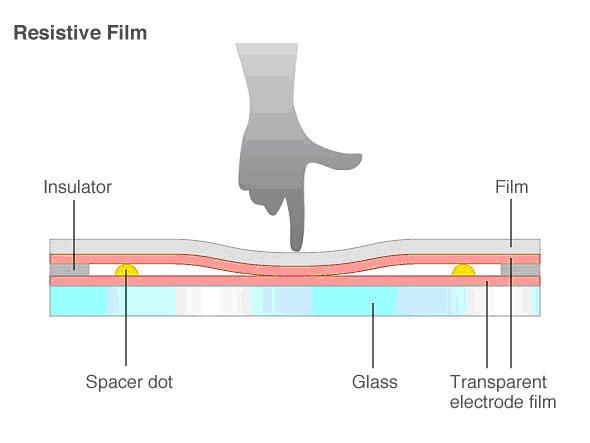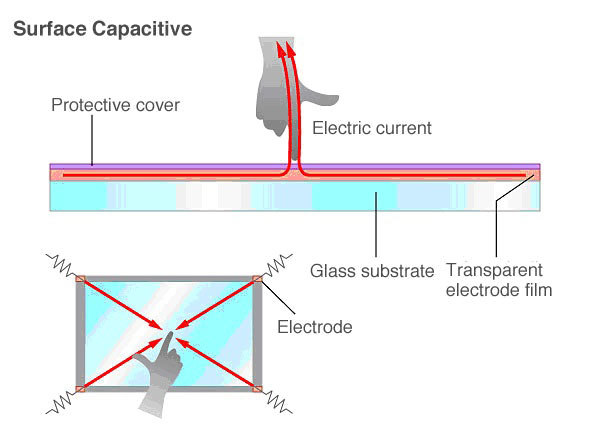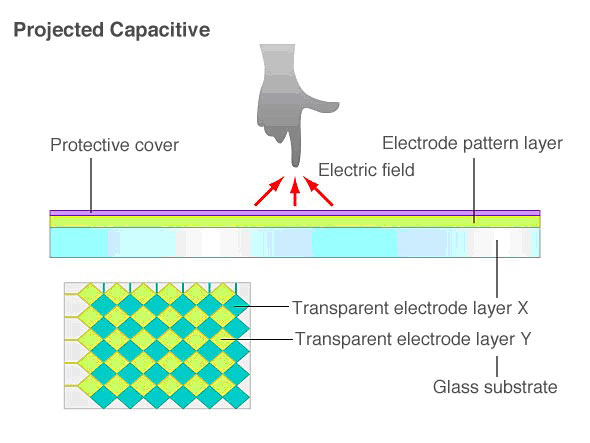Types of Touch Screens For Various Environmental Requirements
Touch screens have become a very common part of our daily lives. Smartphones, handheld video games, car navigation systems, ticket vending machines, kiosks, bank ATMs, and more all use touch panels to enable users to interact with a computer or device without the use of a keyboard or mouse. Even though they are all touch screens, there are several uniquely different types of touch panels. The term touch panel incorporates varied technologies for sensing the touch of a finger or stylus. The most common types are resistive, surface capacitive, projected capacitive, surface acoustic wave, infrared optical imaging, and electromagnetic induction. This article will mainly focus on resistive, surface capacitive, and projected capacitive as these are the touch panels Acnodes Corporation primarily uses for the products.
A major factor influencing the wide spread of touch panels is the benefit offered in the way of intuitive operation. They are easy to understand and easy to use even by people who are inexperienced with computers since they can be used for input through direct icons and buttons. Touch panels also contribute to miniaturizing and simplifying the devices by fusing display and input into a single piece of equipment. Since touch panels are software, not hardware, their interfaces can be easily changed through software. A touch panel requires a wide range of characteristics like precision in position sensing, rapid response to input, durability, installation costs, and most importantly display visibility, their characteristics vary significantly depending on the methods used to sense touch input.
Resistive Type Touch Screen

(Photo courtesy of http://www.eizoglobal.com)
The resistive film is the most widely used sensing method in the touch screen panel market. A resistive touch screen monitor is composed of a glass panel and a film screen, each covered with a thin metallic layer, separated by a narrow gap. When a user touches the screen, the two metallic layers come into contact, resulting in electrical flow. The point of contact is detected by this change in voltage. The front surface is scratch-resistant with a coating of a conductive material.
Advantages:
• Low production cost due to simple structure
• High resistance to surface contaminants and liquids (dust, oil, grease, moisture)
• Can be activated with virtually any object (finger, stylus, gloved hand, pen, etc.)
• Best suited for handwriting recognition
• Low power consumption
• Has tactile feel
Disadvantages:
• Lower image clarity due to lower light transmittance
• Outer polyester film is vulnerable to damage from scratch
• Does not support multi-touch
Surface Capacitive Type Touch Screen

(Photo courtesy of http://www.eizoglobal.com)
The surface capacitive is the second most popular type of touch screens on the market. It is often used in relatively large panels. In a surface capacitive touch screen monitor, a transparent electrode layer is placed on top of a glass panel and covered by a protective cover. When an exposed finger touches the monitor screen, it reacts to the static electrical capacity of the human body; some of the electrical charges transfer from the screen to the user. This decrease in capacitance is detected by sensors located at the four corners of the screen, allowing the controller to determine the touchpoint. Capacitive touch screens can only be activated by the touch of human skin or stylus holding an electrical charge.
Advantages:
• Brighter and sharper image clarity
• Highly touch-sensitive, no need for a stylus
• Supports multi-touch
• Durable screen
• High scratch resistance
• Excellent resistance to surface contaminants and liquids (dust, oil, grease, water droplets)
Disadvantages:
• Sensitivity to EMI/RFI
Projected Capacitive Type Touch Screen

(Photo courtesy of http://www.eizoglobal.com)
Projected capacitive touch panels are often used for smaller screen sizes than capacitive touch panels. Smartphones and handheld devices use this method to accomplish high-precision multi-touch functionality and high response speed. Projected capacitive is similar to surface capacitive, but it offers two primary advantages: in addition to bare fingers, it can also be activated with surgical gloves or thin cotton gloves and it enables multi-touch activation. A project capacitive is composed of a sheet of glass with embedded transparent electrode films and an IC chip, which creates a three-dimensional electrostatic field. When a finger comes into contact with the screen, the ratios of the electrical currents change and the computer is able to detect the touchpoints.
Advantages:
• Excellent image clarity
• More resistant to scratching than surface capacitive
• Resistant to surface contaminants and liquids (dust, oil, grease, moisture)
• Multi-touch
• Highly touch-sensitive, activated via exposed finger, or thin surgical or cotton gloves
Disadvantages:
• Sensitivity to EMI/RFI




